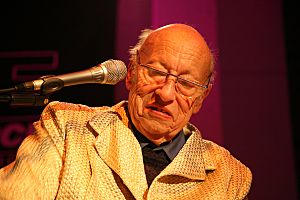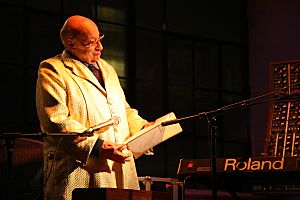Jean-Jacques Perrey facts for kids
Quick facts for kids
Jean-Jacques Perrey
|
|
|---|---|

Perrey at a concert in 2006
|
|
| Background information | |
| Birth name | Jean Marcel Leroy |
| Born | 20 January 1929 Amiens, France |
| Died | 4 November 2016 (aged 87) Lausanne, Switzerland |
| Genres |
|
| Occupation(s) |
|
| Instruments |
|
| Years active | 1951–2014 |
| Labels | MusiCues (1962) Vanguard (1966-1970) Pickwick (1969) Montparnasse 2000 (1971-1980) Oglio Records (2006-2008) Lo Recordings (2007) Forgotten Futures (2017) |
| Associated acts | |
Jean-Jacques Perrey (born Jean Marcel Leroy, January 20, 1929 – November 4, 2016) was a French musician. He was a composer, producer, and performer of electronic music. Many people see him as a pioneer in pop electronica.
Perrey worked with another musician, Gershon Kingsley, to form the duo Perrey and Kingsley. They made some of the first popular recordings using the Moog synthesizer. Perrey was also one of the first musicians to use and promote the Ondioline. This unique instrument was created by Georges Jenny.
About Jean-Jacques Perrey
Early Life and Music Beginnings
Jean Marcel Leroy was born in Amiens, a city in northern France. He received his first instrument, an accordion, when he was just four years old. He also learned to play the piano.
He studied music at a conservatory for a short time. There, he and some friends started a jazz band. They played at school and in public. However, the school director told them they had to choose between jazz and their studies. Perrey was expelled for playing in public. He later finished high school.
Perrey then studied medicine in Paris for four years. He planned to become a scientist. He loved reading science fiction books by authors like Isaac Asimov and Arthur C. Clarke. He also played the accordion sometimes to earn money.
Discovering the Ondioline
In 1950, while still in medical school, Perrey heard about a new instrument called the Ondioline. Its inventor, Georges Jenny, was promoting it on a French radio show. Perrey called the radio station to get Jenny's number. He then called Jenny and said he loved the Ondioline's sound but couldn't afford one.
Perrey offered to promote the instrument if Jenny would give him one for free. Jenny was impressed and loaned him an Ondioline. For six months, Perrey practiced playing the Ondioline with his right hand while playing the piano with his left. Jenny was so amazed by Perrey's skill that he offered him a job. Perrey became a salesman and demonstrator for the Ondioline. After making good money selling the instrument in Sweden, he quit medical school. He decided to focus his career on electronic music.
First Recordings and Performances
In 1951, a famous singer named Charles Trenet heard about the Ondioline. He asked Perrey for a demonstration. Trenet was so impressed that he hired Perrey for a recording session. Perrey played the Ondioline on Trenet's song "L'Âme des poètes" ("The Soul of Poets").
He later played on three more Trenet songs. The famous guitarist Django Reinhardt played on two of those tracks. "L'Âme des poètes" became a worldwide hit. Perrey was then asked to perform on stage with Trenet. This helped Perrey meet other great artists like Yves Montand. He also started performing his own music on French radio and TV.
Perrey began to travel a lot, first in France and then to other countries for music fairs. He created a stage show called "Around the World in 80 Ways." This show highlighted how versatile the Ondioline was.
Perrey's first solo recording was Prelude au Sommeil (Prelude to Sleep) in 1958. He called it an "auditory recipe" to help people with insomnia sleep. He worked with scientists to create sounds that would bring calm to people.
In 1959, Perrey played Ondioline and made sound effects for a children's record. It was called Cadmus, Le Robot de l'Espace. That same year, he played Ondioline for the main theme of the French film The Cow and I.
Moving to New York City
In France, Perrey met Pierre Schaeffer, who created a type of sound art called musique concrète. Perrey then started experimenting with tape manipulation. He also performed with the famous singer Edith Piaf at the Olympia Theater in Paris. Piaf was very impressed by his musical talent.
In March 1960, Perrey moved to New York City. A man named Carroll Bratman helped him. Bratman owned Carroll Music, a company that rented instruments. He sponsored Perrey's move, paid his living costs, and helped him join the musicians' union. Bratman also built Perrey a special studio with advanced tape recorders. Perrey could use any instruments from Carroll Music for free.
After arriving in the U.S., Perrey made two EPs (extended play records) to show off the Ondioline. The first was Mr. Ondioline (1960), and the second was Ondiolinorama (1961).
Perrey appeared on several U.S. television shows, including Tonight Starring Jack Paar and Captain Kangaroo. He also composed jingles for radio and TV commercials. In 1962, Perrey released the album Musique Electronique du Cosmos (Electronic Music from Outer Space). He made this album with Sam Fiedel and Harry Breuer. The short songs on the album were meant for background music on TV and radio.
Perrey & Kingsley and the Moog Synthesizer
In 1965, Perrey met German-American composer Gershon Kingsley at Carroll Music. They formed a duo and recorded two albums for Vanguard. The first was The In Sound From Way Out! (1966), where Perrey played Ondioline. The second was Kaleidoscopic Vibrations (1967), where they mostly played the Moog synthesizer.
Some of their music was used in TV commercials. In 1968, their song "The Savers" won an award when it was used in a soft drink commercial.
After Perrey and Kingsley stopped working together, Perrey continued to use the Moog synthesizer in his solo albums. Many of his album titles included the word "Moog," like Moog Indigo (1970). He also recorded The Happy Moog! with Harry Breuer. Perrey played the Moog, and Breuer played xylophone and other percussion.
Return to Europe
In 1970, Perrey moved back to France. He became the musical director for a ballet company. He also continued to explore how sounds could help people with insomnia. He wrote music for TV commercials and French cartoons. He released several albums of this music.
In 1997, Perrey worked with the French band Air on two songs. The next year, he performed in Brussels, Belgium. In 1999, he created "The Groovy Leprechauns" for an album released by the Beastie Boys' record label. The Beastie Boys had even named an album The In Sound From Way Out! as a tribute to Perrey and Kingsley.
In 2003, a documentary called Jean-Jacques Perrey: Extraterrestrial Musician was made about him. In 2007, Perrey recorded an album called Moog Acid with musician Luke Vibert.
Later Years and Legacy
In 2008, Perrey released the album Destination Space with Dana Countryman. Countryman also wrote a book about Perrey called Passport to the Future in 2010. In 2009, a film documentary about Perrey's life was released, titled Prélude au Sommeil.
In 2013, the musician Wally De Backer, also known as Gotye, was inspired by Perrey's music. He wrote a song and shared it with Perrey. Perrey, who was 80 and living in Lausanne, Switzerland, was very happy. Gotye visited Perrey often and helped him organize his musical work. Gotye also started buying and restoring Ondiolines.
Later, Gotye formed the Ondioline Orchestra. They planned their first performance for November 22, 2016. Perrey was invited, but his health declined. He passed away from lung cancer at age 87, two and a half weeks before the show.
Gotye and the Ondioline Orchestra have performed "Gotye Presents a Tribute to Jean-Jacques Perrey" several times. Gotye also started a record label called Forgotten Futures. Its first release was Jean-Jacques Perrey et son Ondioline, an album of rare and unreleased Ondioline tracks by Perrey.
Discography
Studio albums and EPs
- 1958: Prelude au Sommeil (Institut Dormiphone)
- 1959: Cadmus, Le Robot de l'Espace (with Henri Gruel) (Philips)
- 1960: Mr. Ondioline (Pacific)
- 1962: Musique Electronique Du Cosmos (Electronic Music From Outer Space) (MusiCues)
- 1966: The In Sound From Way Out! (with Gershon Kingsley) (Vanguard)
- 1967: Kaleidoscopic Vibrations: Electronic Pop Music From Way Out (with Gershon Kingsley) (Vanguard)
- 1968: The Amazing New Electronic Pop Sound of Jean Jacques Perrey (Vanguard)
- 1968: Electronic Music (unreleased studio demo acetate)
- 1969: The Happy Moog! (with Harry Breuer) (Pickwick)
- 1969: Switched On Santa (engineer, Moog programming; with Sy Mann) (Pickwick)
- 1970: Moog Indigo (Vanguard)
- 1971: Moog Sensations (Editions Montparnasse 2000)
- 1972: Moog Expressions (Editions Montparnasse 2000)
- 1972: Moog Generation (Editions Montparnasse 2000/Zero International Records)
- 1974: Moog Mig Mag Moog (Editions Montparnasse 2000)
- 1976: Dynamoog (with Gilbert Sigrist) (Mondiophone/Crea Sound Ltd)
- 1977: Moog is Moog (with Harry Breuer) (Editions Montparnasse 2000)
- 1980: Kartoonery (with Daniel Longuein and Guy Boyer) (Editions Montparnasse 2000)
- 1982: Energize with Exercise (with Bette and Ione Darrel) (Black & White)
- 1998: Eclektronics (with David Chazam) (Basetonic; Basta Music)
- 2000: Circus Of Life (with Gilbert Sigrist and O.C. Banks) (Koka Media)
- 2006: The Happy Electropop Music Machine (with Dana Countryman) (Olgio)
- 2007: Moog Acid (with Luke Vibert) (Lo Recordings)
- 2008: Destination Space (with Dana Countryman) (Oglio)
- 2010: Froots (with Cosmic Pocket) (In-Vitro Records)
- 2015: ELA (with David Chazam) (Freaksville)
Compilations
- 1973: The Best Of The Moog (Vanguard)
- 1975: Incredible Synthesizer (Vanguard)
- 1975: The Essential Perrey & Kingsley (Vanguard)
- 2000: Good Moog: Astral Animations and Komputer Kartoons (Kosinus)
- 2001: The Out Sound From Way In! The Complete Vanguard Recordings (Vanguard)
- 2007: Vanguard Visionaries: Perrey & Kingsley (Vanguard)
- 2012: The Electronic Pop Songs (Welk Music Group)
- 2012: Space Age Computer Music (Welk Music Group)
- 2017: Jean-Jacques Perrey et son Ondioline (Forgotten Futures)
- 2019: Past Future Sound Tracks
Soundtracks
- 1959: Les Folles Aventures d'omer et de Jacques Courtois: Omer en Synovie (Polydor)
- 1971: Glop (Riviera)
- 2006: Moog (one track, with Luke Vibert) (Hollywood Records)
Biography
- Brend, Mark (6 December 2012) (in en). The Sound of Tomorrow: How Electronic Music Was Smuggled into the Mainstream. Bloomsbury Publishing USA. ISBN 978-1-62356-153-6. https://books.google.com/books?id=oJHFAgAAQBAJ.
See also
 In Spanish: Jean-Jacques Perrey para niños
In Spanish: Jean-Jacques Perrey para niños


